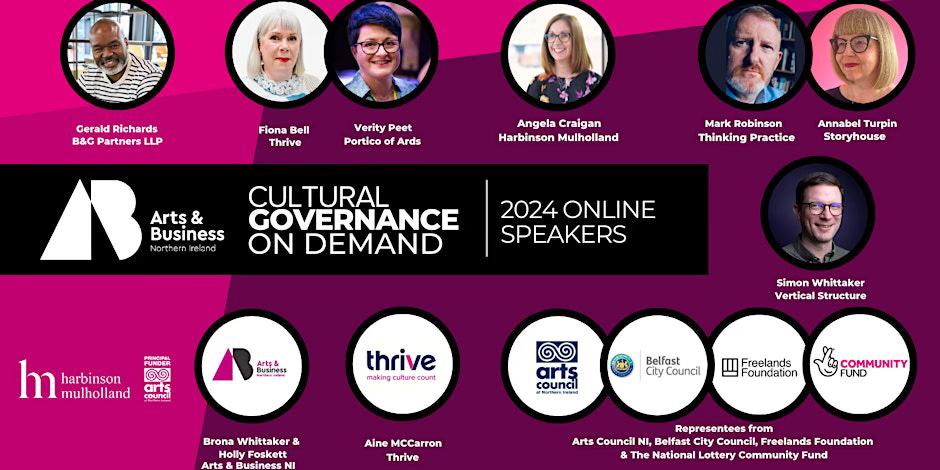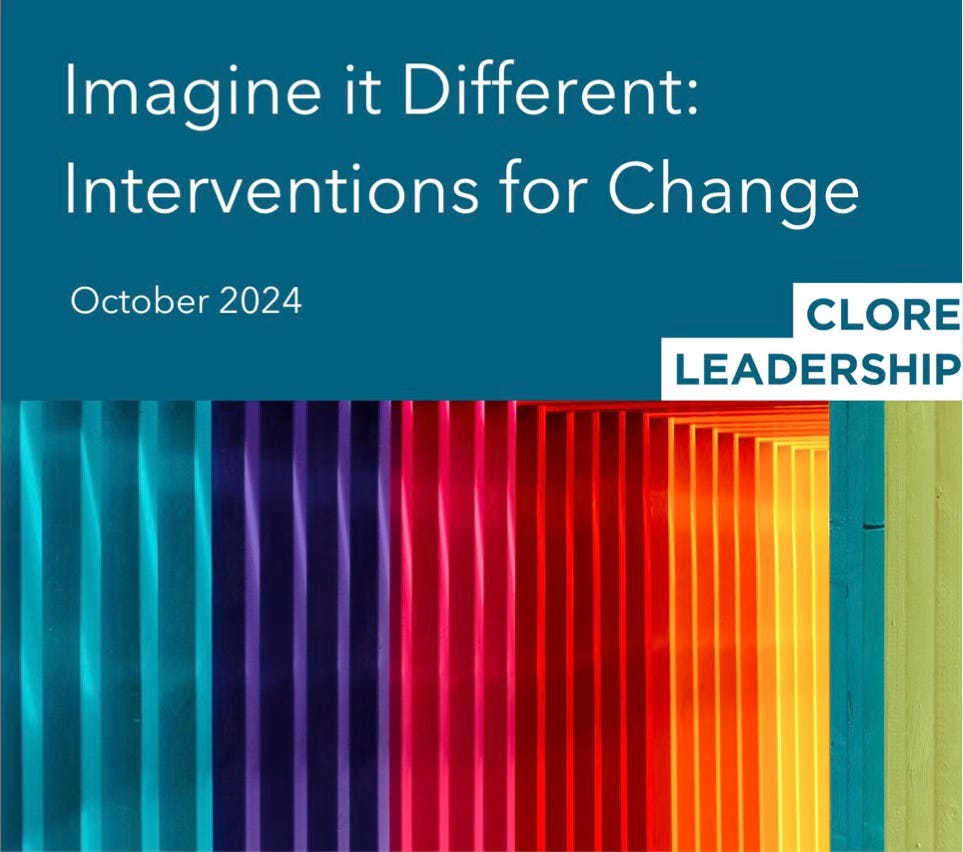A World of Work
Earlier in the year I took part in some gatherings that formed part of the ‘World of Work’ project, spearheaded by Clore Leadership in partnership with Arts Council England, UKRI Arts and Humanities Research Council, and the Paul Hamlyn Foundation. This has now culminated in a new report ‘Imagine It Different: Interventions for Change’ which makes for important and sobering reading.
Interventions for Change
The report does two things very clearly. It paint a depressing picture of the culture-world in England seen through the eyes of a fairly random selection of people, in the first half of 2024. (Importantly, before the General Election.) And it makes some sensible suggestions for positive actions for the short, medium and long-term, some of which are already being worked on by partners. (ACE are apparently working on reducing the burden of reporting – it’s not for the first time, obvs, but it is welcome.)
My sense of the rooms I was in was they had a decent mix of established leaders of funded organisations at different scales, some newer CEOs and artistic directors, a smattering of individual artists, and a few more or less unaffiliated opinion-mongers like me. The groups skewed younger than me, but then most rooms do these days. They were good lively discussions, but there was some underlying stress which is confirmed by the report, and a lack of transformational energy.
Stress responses
In the current situation we see massive stress responses. Leaders are under siege and overwhelmed by cuts, rising costs, polarised politicisation, global crises and atrocities, climate change et al. (I can imagine a few reading this and feeling got at for not being non-hierarchical enough, as their ships spring leaks on all decks.)
Leaders with formal power are tightening belts, approaches and, arguably, minds, reverting to old-fashioned managerial types. Control – ‘gripping the situation’ - is demanded by funding regimes and boards alike.
Hierarchical, inflexibly managerial preferences comes out at such times, rather than more liberating and radical practices of reinvention-in-the-face-of-challenge. As the report puts is: “Leaders [are] drawing most often on skills that suggest individual responses and ‘leader led’ solutions, rather than a systems leadership approach which is increasingly recognised as more effective in other sectors.”
Ditching the hierarchy
Understandable as that might be on a human level, this is not heartening reading for me, given how much I’ve argued there was a tide – a helpful, necessary one - towards non-hierarchal leadership in arts and culture. I’ll quote the conclusion to the post I wrote to mark the publication of Tactics for the Tightrope in 2021, which summarises the arguments of that book:
“… we will need to remember a handful of basic principles that make creative resilience a form of resistance instead of co-option. How we work must build resourcefulness and creative capabilities in ourselves, in others and the collective. We should ditch hierarchical leadership models to connect, collaborate and multiply many, many voices. Our creative resilience should be a process of resistance. We should make ourselves useful and make space for others, even as we take up our own. Finally, we should keep some slack for ourselves and resist all temptations to ‘give 110%’ and thus undermine our own creative resilience.”
Every time I put such arguments into the world, a tiny bit of me expects the world to change. But a larger bit of me know this is more complex than that: that each argument adds a wave, a disturbance, that will take its own sweet time adding its strength to others. This is why I do not ultimately find it depressing for more than a few minutes at a time that we must make the same arguments time and again: this is long-term stuff. (This may seem to you like me consoling myself. I find this, too, a necessary part of the process.)
Interventions for Change makes a clear argument for some strategic actions that could make a real difference. Some of this is mindset stuff, some more to do with what you might call ‘basics and professional standards’. The continuing lack of a commonly agreed set of core skills, responsibilities (eg of commissioners as well as artists), managerial, ethical and governance standards is probably unlikely to end soon, given the nature of the sector – people will provide an exception for every rule – but it is a weakness of the sector in term of both advocacy and many people’s experience of working in it.
Sectoral ingenuity
The answer does not, though, lie in mimicking the commercial sector, as is hinted a couple of times. My eyebrows leap at sentences such as “insights from the commercial sector highlighted the importance of merging altruistic goals with financial viability, emphasising the need for flexibility in governance and structure.” This seems too easy an acceptance of the cleansing qualities of CSR.
Most cultural leaders need few lessons in viability from the commercial sector who brought you such screenplays as The Deserted High Street or Our Bonuses, Your Polluted Rivers, or the very real Mr Bates vs The Post Office. Not mention Wilko, Debenhams, Ted Baker, Body Shop, Laura Ashley from the many brands hitting administration in recent years. Or from Spotify, Meta and the AI crew whose ‘scraping’ is often just theft from unlawyered-up creatives. (As argued really clearly by Joel Morris by way of Davids Graeber and Wengrow recently.) Our sector has the ingenuity to find support where it fits, if ideas can be freed and rewarded equitably.
Concentrating influence
One of the points made in a round of workshops I led for the National Lottery Heritage Fund recently was that leaders were often over-connected in under-productive networks and groupings. This was particularly an issue for a small number of people who get invited to take part in most strategic gathering and conversations, because they are good collaborators and have insight and imagination to bring.
These people are often CEOs, but certain artists and freelancers can find themselves in this situation too. My point is not a criticism of the individuals whatsoever – heaven knows I have at points in the past been one of the Usual Suspects myself, although I think I have moved out of that phase somewhat. (Early in my arts career, I knew I was getting somewhere when Northern Arts started co-opting me onto things. It’s a slippery slope…)
But it is a criticism of the system that – if left to ‘natural’ forces – tends to concentrate influence. Them that’s got shall get, as the old saw has it. This is a burden for those individuals – especially those from minoritised backgrounds who often have the responsibility of representation put upon them implicitly or explicitly, whether they want it or not – and for their organisations or creative practices.
Beyond the Usual Suspects SMT
I would have liked to have seen more emphasis on the benefits of distributing this aspect of leadership work, as part of the change agenda which is at the heart of this report. If leaders are feeling under siege, so are many of their staff. I’ve helped a few big organisations bring all their staff together to think about the future, as well as smaller ones, and every time ideas and passion come from all corners. We need more of that. We also need more it at a sectoral level: the equivalent of ‘all staff’ workshops that go beyond the Usual Suspects SMT.
One last thing…

Talking of busy usual suspects…
…me and Annabel Turpin, of Storyhouse were recently invited by Arts and Business Northern Ireland to construct a conversation about evaluation and strategic planning for the online version of their Cultural Governance Conference. So busy were both our diaries we had to record it very early in the morning. It got the day off to an energising start!
You can access it, for a small consideration, until December by following the clues/instructions here:
https://www.eventbrite.co.uk/e/cultural-governance-conference-2024-tickets-972030167397




Just a small and quick note of appreciation for your helpful sharings.